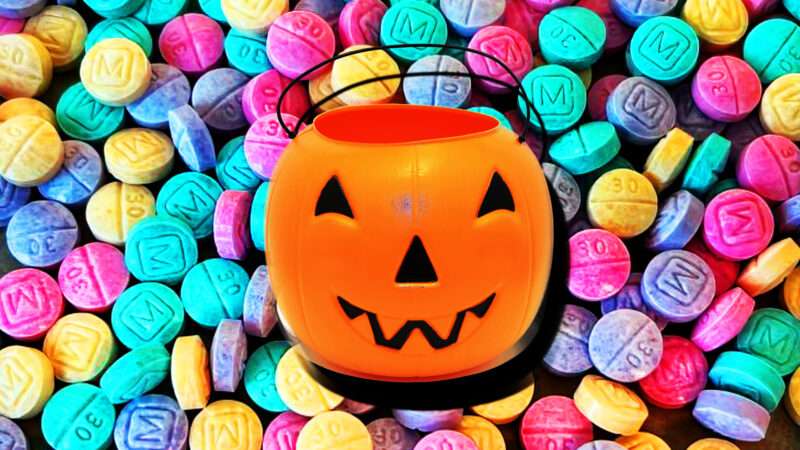
Despite a lack of evidence, urban legends about drug-laced Halloween candy keep circulating, aided by feckless reporters. This year, it’s “rainbow fentanyl” that has the press repeating unfounded tales of deadly drugs disguised as candy.
While the narrative around rainbow fentanyl and children—that drug dealers are selling brightly colored pills to appeal to kids, or even worse, getting them hooked on the drug by hiding it in Halloween candy—is bunk, journalists just won’t stop peddling the story. This week, it was Good Morning America that repeated myths about rainbow fentanyl’s appeal to trick-or-treaters this Halloween. While it is irresponsible to present a misleading story to an audience, recent stories about rainbow fentanyl are particularly reckless because of their potential to provoke widespread, baseless panic among parents.
Local news outlets have been reporting on rainbow fentanyl throughout the summer, but stories about the drug’s supposed threat to children intensified following a Drug Enforcement Administration press release on August 30. It warned about the colorful fentanyl pills, writing that “this trend appears to be a new method used by drug cartels to sell highly addictive and potentially deadly fentanyl made to look like candy to children and young people.”
That said, there is no concrete evidence that the pills are being marketed to kids. Other kinds of drugs, like “heroin packets, for instance, come stamped with all kinds of edgy names and images,” wrote Lenore Skenazy, president of the childhood independence nonprofit Let Grow, for Reason. “These undoubtedly appeal to a certain segment of the market. But that segment is not children.”
Tales of razor blade–filled apples or poisoned Pixy Stix have gripped parents before. However, almost all cases of poisoned or manipulated Halloween candy are hoaxes, jokes gone wrong, or complete misunderstandings. University of Delaware social scientist Joel Best has extensively studied “Halloween sadism.” Observing the period from 1958–2012, he found no reported cases where a child was killed or seriously injured by poisoned or manipulated candy picked up during trick-or-treating. While Best has found 100 reports of sharp objects (like razors or pins) being found in candy between 1958 and 2018, they have resulted in few injuries—the worst required about a dozen stitches.
According to Best, the few cases where children have been killed on Halloween after eating candy have been more complex than media first reported. For example, in 1974 a boy died after eating cyanide-laced Pixy Stix. The candy was poisoned by the boy’s father in an attempt to cash in on a large life insurance plan. The media also reported deaths among children who had died from unrelated medical conditions shortly after eating normal candy.
Even though the press could’ve learned this lesson, it hasn’t. Outlets ranging from Fox News to Newsweek have picked up the rainbow fentanyl story. Reporters have speculated that these pills could end up in children’s Halloween candy. On Wednesday, Good Morning America connected the myth to a recent seizure of 15,000 fentanyl pills, which were smuggled in a Lego box. The segment was presented as “a warning, certainly one, here, that parents need to hear with Halloween coming up. It’s about potentially deadly fentanyl pills that look like candy,” said anchor T.J. Holmes. “This story is so concerning,” added reporter Stephanie Ramos. “Doctors, especially concerned the pills may appeal to teens or young adults.”
The notion—not just that drug dealers are giving out free drugs in an attempt to hook children on fentanyl, but that they’d do it through disguised Halloween candy—is dubious. “I’m skeptical that [dealers] would try to target children where there is not an existing market,” Sally Satel, an addiction psychiatrist and resident fellow at the American Enterprise Institute, told Skenazy. Noting that the risk of overdose in children is huge, Satel said that “few would survive and come back for more.”
Despite warnings that it will end up in Halloween candy, the only thing that’s spooky about rainbow fentanyl is that journalists keep pushing stories about its risk to trick-or-treaters.
The post Undeterred by Past Failures, the Press Goes All in on 'Rainbow Fentanyl' Panic appeared first on Reason.com.
from Latest https://ift.tt/9RM1QYn
via IFTTT